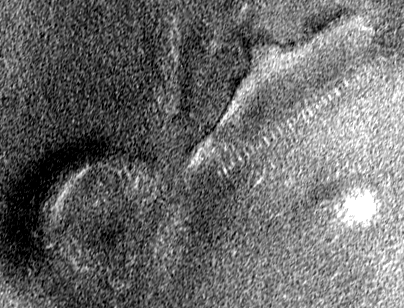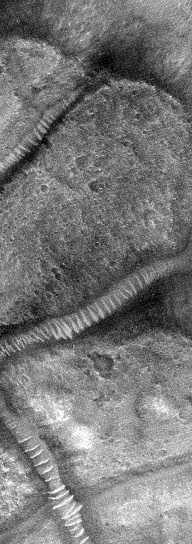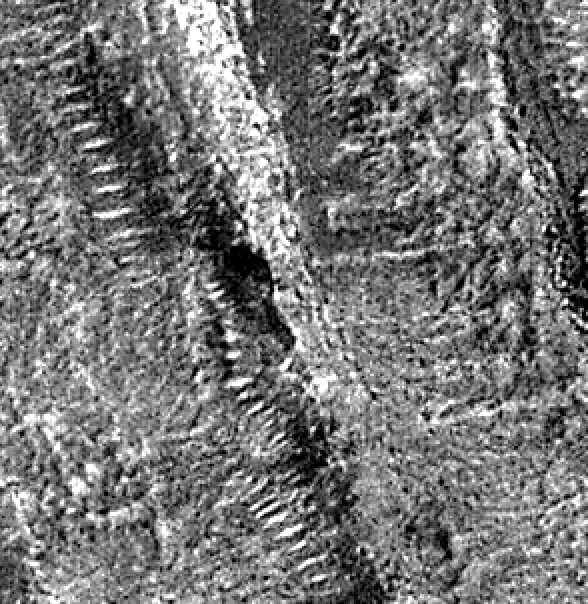"Glassy tubes" on Mars are sand dunes?
Dave Pieri of JPL suggests that the ubiquitous "tubes" on Mars are sand dunes. [<http://www.sightings.com/general9/jpl.htm>] Let's look at this in two parts:
- The white bands. Pieri is really trying to explain only the white bands, not the glassy tubes, as dunes. We see these in many places -- there must be thousands of examples by now. SPSR geologists ruled out dunes early-on as a viable explanation because of considerations such as these:
- "Winds" on Mars are insufficient to build large dunes. The surface atmosphere on Mars is roughly 1% that on Earth, and Earth's is in turn only about 1% that on Venus. The atmosphere on Venus is so thick that a 7-mph wind has hurricane force. Analogously, winds on Mars would have to reach hurricane speeds to be felt as the gentlest of breezes. They would require substantially greater speeds to develop enough lift to perform large dune-building on otherwise flat terrain. Jet-stream speeds might arise at higher altitudes, as they do on Earth; but are least likely at the surface.
- Below-surface winds require channeling. The white bands are often seen in cracks and fissures. These ought to be sheltered from surface winds. The exception would be a case where a canyon had a wide mouth at one end that could collect a large volume of wind and channel it into a much narrower canyon. However, the cracks and fissures containing white bands are not of that character.
- The white bands are perpendicular to adjacent features. Where the white bands are seen on the surface of Mars (the "crenulations"; e.g., Fig. A), they often align perpendicular to adjacent surface features. It is easy so see how sand might be blown up against a surface feature and pile up there, but such piles would be elongated along the surface feature. The surface feature might perform a one-sided channeling of the winds, but that is inconsistent with individual white bands showing no width, height, or spacing variation with distance from the surface feature.
- The white bands have appreciably higher albedo than the surface material around them. Dunes ought to be made of the same material as the nearby surface, but wind-blown and deposited in wave-like patterns. However, the same material should cover all nearby terrain. But the actual white bands are sharply brighter than the material between them, and in some cases brighter than anything on the surrounding terrain.
- The glassy tubes. In a few places where the surface is cracked or where erosion has exposed what was previously buried, we see the white bands as markings on, or bands around, glassy tube-like structures (e.g., Fig. B). The "dunes" hypothesis does not explain these features.
- The glassy tubes have distinct outlines. Nothing about the "dunes" hypothesis requires that the extremities of the dunes be connected by an outline, yet the "flat view" interpretation of the glassy tubes is that they are outlines paralleling or connecting the extremities of the dunes.
- A glassy tube appears to produce a specular reflection of sunlight. In one case, a roundish spot of saturated white light appears on a glassy tube (Fig. D). It is positioned on the side toward the Sun, and is positioned such that a specular reflection of the Sun is a possible explanation. As a singular, very bright spot near the end of a section of glassy tubing, no other obvious explanation suggests itself, and any invented for the purpose would be ad hoc. Because natural terrain scatters sunlight, if this spot is reflected sunlight, that would be consistent with tubules of a glassy or plastic-like quality.
- The glassy tubes cast shadows. Where shadows can be seen, they are consistent with the glassy tube interpretation, but not always with the "dunes" interpretation. In some cases, such as the glassy tubes on the "Cliff" at Cydonia (Fig. C), the shadows are clearly cast by tube-like features. The shadows are beside the tubes on the side opposite the Sun, parallel the tubes, and narrow when the tubes narrow. No "dunes" or other alternate interpretation to the tubes is available for such cases.
tvf -- 2001/03/13
[Additional "tubes" and other images will appear in the 2001 March 15 Meta Research Bulletin, available in early April.]

A

B

C

D
